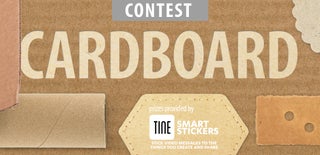Introduction: Paper/ Cardboard Differential
Greetings!
For this tutorial, we will be constructing a Differential out of paper or paper based products. I used Studio Decor Mat Board that is 1/16 of an inch thick to construct my differential, but cardboard or other thick, sturdy paper based products will also work. Included on this step are the three files you will need to cut the gears and other parts out of your material with a laser cutter. The housing parts SVG file should already be scaled correctly, but if it isn't quite correct, the circles with the cutouts should be three inches in diameter and everything should fit within a 24 inch by 12 inch cutting area. The bevel gears are separated into two files, Beveling and Cut. I would highly suggest running the Beveling file first since the layers may be slightly off if you cut first.
The settings I used for the laser cutter were as follows for the Beveling file:
Color Speed Power Frequency
Red 65 75 500
Green 40 75 500
Blue 40 75 500
Cyan 40 100 500
I turned Raster off for the cyan color. You will need to run Beveling and Cut three separate times to get the three bevel gears we will need for this project. I would Highly recommend using the Mat Board for these gears as it has a more consistent substance throughout.
You will also need some lollipop sticks, I am using sticks that are six inches long and just shy of 3/16 inches in diameter.
Step 1: Step 1: Adding the Layers Together
In this step, we will be putting the layers together where they need it for later construction. The three large gears will need to be attached to each other to form a thicker large gear, Try to get the gears to be as close to each other as possible, it will work better with other gears if the teeth are smooth. Do the same with the three small gears.
Only two of the circles with cutouts need to be attached to each other, though the procedure is the same as with the gears.
The rectangles need to be glue together so there are two of them each six layers thick. BE SURE TO LINE UP THE HOLES THROUGHOUT. The holes are not centered along the long edge to accommodate the extra depth of the second circle part.
Step 2: Step 2: Adding the Cutouts to Create the Housing Ends
In this step, we shall add the cutout portion to the large and small gears. The holes must line up to allow for smooth motion of the axles. The double layer cutout portion will attach to the small gear and should be slightly larger the the outer diameter of the smaller gear.
Step 3: Step 3: Finishing the Housing Portion of the Differential
In this step, we will glue the rectangles on their ends within the cutout on the circles. It would be best to make sure the holes on the rectangles do not line up, as this allows for one hole to be in the correct place. The ends of the rectangle should meet with the gears on each side .
Step 4: Step 4: Adding the Spacers and the Bevel Gears on the Ends
For one side of the differential, line up two layers of the smaller circles to help space the bevel gear properly within the differential. Slide a lollipop stick through the hole as this will act as our axle. It may be necessary to modify the axle or the gear in order to fit the axle in the gear. Once the axle is through the bevel gear, secure the bevel gear to the axle with a small circle of whatever material you are using. I unfortunately did not have the files for these, but mine are 3/4 inch circles with a hole cut in the middle. One will also need to be secured to the axle on the outside of the differential to keep the gear from moving back and forth, but do not secure the axle to the housing.
Repeat this step for the other side.
Step 5: Step 5: Adding the Center Gear
For this step, locate which side of the housing is the better side to allow for the gear's hole to line up with the hole in the side of the housing. Once you have figured this out, line up the final spacer circle with the hole in the side of the housing and secure it. Slide the gear into place and secure it with a small portion of a lollipop stick. this should keep the gear in the correct location but not inhibit it's motion.
If everything is done properly, you should be able to turn either axle in any direction at any speed regardless of the actions of the other gear. Due to this being paper, it won't function as smoothly as a precision made differential in a vehicle, but should still work to demonstrate their function.

Participated in the
Cardboard Contest 2016

Participated in the
Maker Olympics Contest 2016











